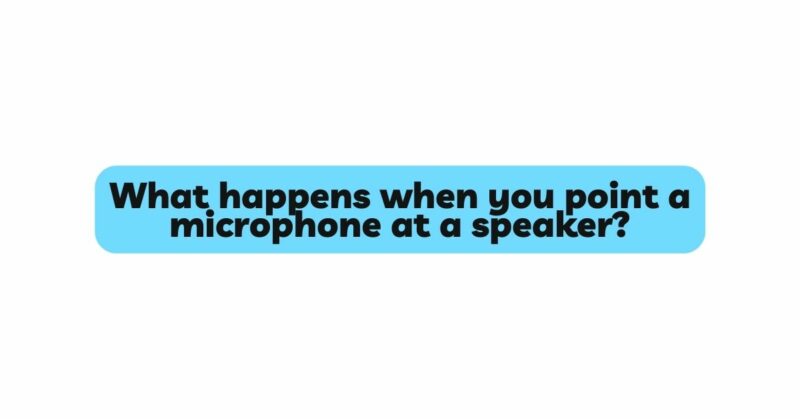In the symphony of audio technology, where sound waves and electrical signals harmonize to create captivating experiences, curious minds often find themselves pondering the consequences of unconventional interactions. One such scenario involves pointing a microphone at a speaker. This article delves into the intriguing phenomenon that occurs when a microphone’s sensitivity meets the resonant power of a speaker, exploring the science behind the interaction, the potential outcomes, and the implications for sound engineers, enthusiasts, and audio technology aficionados.
The Dance of Sound Waves and Technology: Before delving into the intricacies of pointing a microphone at a speaker, it’s essential to understand the roles of microphones and speakers in the realm of audio.
Microphones are devices that convert acoustic sound waves into electrical signals. They employ transducers that translate the variations in air pressure caused by sound waves into corresponding voltage changes. Microphones come in various types, each designed to capture specific frequencies and patterns of sound.
Speakers, on the other hand, are engineered to convert electrical signals into audible sound. They utilize diaphragms that vibrate in response to the electrical currents, generating sound waves that radiate into the environment. Speakers are optimized to produce specific frequency ranges and patterns of sound.
The Phenomenon: Feedback and Resonance: Pointing a microphone at a speaker creates a feedback loop, which occurs when the output sound from the speaker is captured by the microphone and then amplified and re-emitted by the speaker again. This self-perpetuating loop generates a phenomenon known as acoustic feedback.
Acoustic feedback is characterized by a high-pitched, often screeching sound that gradually builds up in volume. It occurs when the microphone captures sound from the speaker, sends it back through the audio system, and amplifies it again through the speaker. The repeated amplification and emission of the captured sound result in a cycle that leads to the distinctive feedback sound.
Understanding the Feedback Loop: The feedback loop that occurs when a microphone is pointed at a speaker can be broken down into several stages:
- Capture: The microphone captures sound emitted by the speaker and converts it into an electrical signal.
- Amplification: The electrical signal is transmitted to the mixer or amplifier, which increases its strength.
- Re-Emission: The amplified signal is sent back to the speaker, causing the diaphragm to vibrate and produce sound waves.
- Capture (Again): The microphone captures the re-emitted sound waves from the speaker and converts them into a new electrical signal.
- Amplification (Again): The new electrical signal is further amplified, increasing its strength once more.
- Re-Emission (Again): The amplified signal is sent back to the speaker, continuing the cycle.
Consequences and Implications: The feedback loop resulting from pointing a microphone at a speaker has several consequences and implications:
- Sound Distortion: The repeated amplification and re-emission of sound waves lead to distortion and the characteristic high-pitched screech of acoustic feedback.
- Audio Clarity: Acoustic feedback disrupts the clarity of sound reproduction, making it difficult to discern the original audio signal.
- Equipment Stress: The feedback loop places stress on both the microphone and the speaker, potentially damaging components if the loop is not interrupted promptly.
Preventing and Managing Acoustic Feedback: Sound engineers and enthusiasts employ various techniques to prevent or manage acoustic feedback when pointing a microphone at a speaker:
- Adjusting Microphone Placement: Changing the angle and distance between the microphone and the speaker can help minimize the chances of feedback.
- Using Directional Microphones: Directional microphones, such as cardioid or supercardioid microphones, are less sensitive to sound from certain directions, reducing the likelihood of capturing sound from the speaker.
- Applying EQ and Filters: Applying equalization (EQ) and filters to the audio signal can help attenuate frequencies that are prone to feedback, reducing the risk of resonance.
- Using Feedback Suppressors: Feedback suppressors are devices that analyze the audio signal and automatically apply filters to eliminate frequencies causing feedback.
- Soundproofing and Acoustic Treatment: Implementing soundproofing and acoustic treatment in the environment can help reduce the overall sound reflection and resonance, mitigating feedback potential.
Conclusion: Pointing a microphone at a speaker triggers a captivating dance of sound waves and technology, resulting in the phenomenon of acoustic feedback. Understanding the mechanisms behind this interaction, along with employing strategies to prevent or manage feedback, is crucial for sound engineers, performers, and audio enthusiasts. As audio technology evolves, embracing this delicate balance between sound capture and reproduction enriches our ability to create and experience immersive auditory landscapes.


